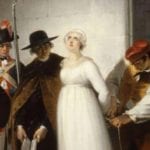 Politics
Politics  Politics
Politics  Weird Stuff
Weird Stuff 10 Freaky Times When Famous Body Parts Were Stolen
 Miscellaneous
Miscellaneous 10 Interesting Things Manufacturers Stopped Making and Why
 Gaming
Gaming 10 Funny Tutorials in Games
 History
History 10 Fascinating Little-Known Events in Mexican History
 Facts
Facts 10 Things You May Not Know about the Statue of Liberty
 Movies and TV
Movies and TV 10 Movie Adaptions That Brought Popular Songs to Life
 Health
Health 10 Miraculous Advances Toward Curing Incurable Diseases
 Miscellaneous
Miscellaneous 10 Undeniable Signs That People’s Views of Mushrooms Are Changing
 Animals
Animals 10 Strange Attempts to Smuggle Animals
 Politics
Politics 10 Countries Where Religion and Politics Are Inseparable
 Weird Stuff
Weird Stuff 10 Freaky Times When Famous Body Parts Were Stolen
 Miscellaneous
Miscellaneous 10 Interesting Things Manufacturers Stopped Making and Why
Who's Behind Listverse?

Jamie Frater
Head Editor
Jamie founded Listverse due to an insatiable desire to share fascinating, obscure, and bizarre facts. He has been a guest speaker on numerous national radio and television stations and is a five time published author.
More About Us Gaming
Gaming 10 Funny Tutorials in Games
 History
History 10 Fascinating Little-Known Events in Mexican History
 Facts
Facts 10 Things You May Not Know about the Statue of Liberty
 Movies and TV
Movies and TV 10 Movie Adaptions That Brought Popular Songs to Life
 Health
Health 10 Miraculous Advances Toward Curing Incurable Diseases
 Miscellaneous
Miscellaneous 10 Undeniable Signs That People’s Views of Mushrooms Are Changing
 Animals
Animals 10 Strange Attempts to Smuggle Animals
Ten Inspirations for Famous Fictional Detectives
The inspiration for famous fictional detectives is a topic of great interest among fans of the genre and, to a large extent, the general public as well. So, where do writers come up with their ideas about the often peculiar personality traits and the methods of such engaging characters?
As it turns out, most are based on either actual people or members of their own ranks: fellow fictional detectives. As this list of 10 inspirations for famous fictional detectives shows, there is good reason for the enduring curiosity about the origins of these engaging sleuths.
Related: 10 Legendary Exploits Of The Pinkerton Detective Agency
10 The Right Reverend Monsignor John O’Connor and Father Brown
Father Brown, the humble Roman Catholic priest, solves crimes based on his understanding of human nature as illuminated by his Christian faith as much as he does by his analyses of clues. As such, he remains as popular today as he was when G. K. Chesterton (1874-1936) first introduced him to the world in his 1910 short story “The Blue Cross.” The character has not only appeared in several of Chesterton’s own volumes but also in several movies and television series. Currently, he is the protagonist of the BBC One series Father Brown, starring Mark Williams, which is now in its ninth season.
The inspiration for this enduring character was himself a man of the cloth, the Right Reverend Monsignor John O’Connor (1870-1952). And he taught Chesterton a lesson the famous writer would never forget. After a spirited philosophical discussion with two Cambridge University students, during which Chesterton was present, O’Connor retired for the evening. The students then admitted that the clergyman was, indeed, a wise and brilliant man but, due to his vocation, most likely rather “insulated and naive.”
Chesterton was much amused by their opinion, having been earlier shocked at learning just how much O’Connor knew about “certain perverted practices.” This, of course, was the result of his having heard the confessions of those who had performed such acts. Chesterton had found a model for his own priest-detective, who would solve mysteries by practicing the arts of both the rational detective and the spiritual priest.[1]
9 Dr. Joseph Bell and Sherlock Holmes
In an interview with The Strand magazine in which his short stories concerning his world-famous detective were published from 1887 to 1927, as well as in radio interviews and his 1923 autobiography Memories and Adventures, Sir Arthur Conan Doyle (1859-1930) explains the origin of Sherlock Holmes. During his student days, Doyle served as a clerk at the Edinburgh Royal Infirmary for the surgeon who became his mentor, Dr. Joseph Bell (1837-1911).
In this capacity, Doyle was able to observe how Bell interacted with his outpatients and learned that the physician was able to discover more about them by his own observations and inquiries than Doyle had obtained by questioning them directly before their appointments occurred. As a result of seeing Bell at work, Doyle wrote, “I used and amplified his methods when in later life I tried to build up a scientific detective who solved cases on his own merits and not through the folly of the criminal.”[2]
8 Jacques Hornais and Hercule Poirot
Philosophers warn us not to confuse correlation with causation. Coincidences may be intriguing, but they don’t prove anything. Still, there could be a cause-effect connection between such incidents. The problem is that such a link cannot be demonstrated. Nevertheless, the striking coincidences between Agatha Christie’s possible acquaintance with refugee Jacques Hornais (1857-1944), a Belgian gendarme whose actual surname was Hamoir, and the detective Hercule Poirot she would later create are suggestive, indeed. Not only are they both Belgian, but they are also detectives—and there is a striking resemblance between Hornais and Poirot, whom Christie (1890-1976) describes as exhibiting a “stiff” bearing and wearing a mustache.
There is more reason to suppose that Christie may have modeled Poirot on Hornais. In her autobiography, the author herself muses, “We had quite a colony of Belgian refugees living in the parish of Tor. Why not make my detective a Belgian? I thought. There were all types of refugees. How about a refugee police officer? A retired police officer.” Despite the lack of definitive proof, the possibility that the refugee Belgian police officer inspired Christie’s Belgian detective is intriguing enough to warrant further investigation.[3]
7 Eugène François Vidocq and C. Auguste Dupin
Despite the brevity of his life, Edgar Allan Poe (1809-1849) was not only productive, but he was also inventive, creating both the modern psychological horror story and the amateur detective story that would become the model for the detective fiction that followed. His detective, C. Auguste Dupin, made his debut in Poe’s 1841 short story “The Murders in the Rue Morgue” and reappeared in two subsequent stories, “The Mystery of Marie Roget” and “The Purloined Letter.” As Sir Arthur Conan Doyle points out, “There is no doubt that in the Dupin tales, Poe created the basic template for the detective stories of the future.” However, Doyle takes issue with Dupin’s flat, lackluster character.
Poe’s own source was Eugène François Vidocq (1775-1857), who lived in France at a time during which neither France nor Britain had either police forces or detectives. It was not until the 1820s that the Sûreté, or “French crime bureau,” was formed and not for over two decades later, in 1842, that London’s Metropolitan Police (aka Scotland Yard) added detectives to its force. Lacking a law enforcement source for a model, Poe based Dupin on Vidocq, the former criminal mastermind who’d reinvented himself as a private detective after serving as the Sûreté’s chief. According to Doyle, Poe used “the folly of the criminal [to] build up a scientific detective who solved cases on his own merits.”
A New York Times article summarizes Vidocq’s contributions to criminology. Long before such matters were customary in police work, he was looking into fingerprinting, ballistics, blood tests and the use of science to fight criminals.[4]
6 Jim Grant, Lawrence Dallaglio, and Jack Reacher
The protagonist of Lee Child’s thrillers, Jack Reacher, is derived from a mixture of sources, including Child himself. According to Bryan Curtis, Child (the pen name of Jim Grant) is, like Reacher, a former U.S. Army military police officer who drinks an excessive amount of coffee every day, chain smokes, wears jeans and a T-shirt, and tends to be taciturn. Reacher, it so happens, is also the same height as his creator, “six-foot-five.” However, Reacher’s size, like his appearance, is also based on that of former professional soccer player Lawrence Dallaglio, who stands in at six-feet-four. Perhaps with Dallaglio in mind, Child has described Reacher’s face as looking “like it had been chipped out of rock by a sculptor who had ability but not much time.”
In developing Reacher’s character, Child used multiple sources, including stories of the knight-errant, the mysterious stranger, the Japanese ronin myth, and Robin Hood, a type of “character he says, that, “forced out of Europe as Europe became more densely populated and more civilized,” migrated to the American frontier.[5]
5 Dave Toschi, “Dirty” Harry Callahan, and Frank Bullitt
Clint Eastwood’s Inspector “Dirty” Harry Callahan, who appears in Dirty Harry (1971) and four other gilms, along with Steve McQueen’s Lieutenant Frank Bullitt, of Bullitt (1968), are both based on the same person, the San Francisco Police Department’s Inspector David Toschi (1931-2018).
https://www.sfchronicle.com/news/article/SF-cop-who-hunted-Zodiac-killer-dies-Dave-Toschi-12488886.php
According to Kevin Fagan, it was Toschi’s “penchant for bow ties, snappy trench coats and the quick-draw holster for his .38-caliber pistol [that] drew the attention of Steve McQueen (1930-1980), who patterned his character after” the dapper detective, and Clint Eastwood’s Dirty Harry character was also “partially inspired by him.”
Eastwood got the role after Frank Sinatra (1915-1998) and Paul Newman (1925-2008), the initial choices for the part, turned them down. Sinatra because an injury to a tendon in his hand made it painful to hold a gun, and Newman because he “objected to its politics.” Ironically, Toschi seemed to regard Eastwood as an unlikely choice for the part. Despite his stardom, Toschi said, Eastwood’s detective impressed him as “an almost shy person [dressed in] faded jeans, a T-shirt, [and] white tennis shoes.”[6]
4 Porfiry Petrovich, Father Brown, and Columbo
Bing Crosby (1903-1977) would have played the disheveled, one-eyed, cigar-chomping police detective in the wrinkled trench coat had William Link (1933-2020) and Richard Levinson (1934-1987), the creators of Frank Columbo, had their way. However, the part went, instead, to Peter Falk (1927-2011). The actor’s portrayal of the seemingly scatterbrained, humble inspector created as enduring a character as exists in the history of Hollywood. To create their star detective, Link and Levinson based Columbo on both Porfiry Petrovich and Father Brown.
As childhood friends, Link and Levinson had long enjoyed detective stories and mysteries. They were fans of Crime and Punishment (1866) by Fyodor Dostoevsky (1821-1881), from which they borrowed aspects of Porfiry Petrovich, and of G. K. Chesterton, whose Father Brown provided both Columbo’s humble demeanor and his ability to seemingly disappear among others who thought the cop apparently irrelevant. As Shaun Curran points out in his online BBC Culture article, Columbo’s “distinctive posture, exaggerated hand gesticulations and a contrived forgetfulness—his habit of leaving a room, only to return having remembered ‘just one more thing’ became his trademark.”[7]
3 Inspector Clouseau, Lt. Columbo, Sherlock Holmes, Porfiry Petrovich, and Adrian Monk
Adrian Monk, of the television series Monk, was based on more other fictional detectives than most of his peers. The first inspiration for the obsessive-compulsive detective was inept Inspector Clouseau of Pink Panther fame. However, the French detective was not Monk’s creators’ inspiration. Instead, it was that of an ABC executive “looking for an Inspector Clouseau-type show.” It was co-creator David Hoberman who thought up a brainy investigator who not only had a welter of personal problems but also suffered from an obsessive-compulsive disorder, as Hoberman did himself. Although the condition was never officially diagnosed, Hoberman related, Monk’s compulsion to “walk on cracks [and] to touch poles” was inspired by Hoberman’s own perceived need to do so.
Monk is also influenced by Sir Arthur Conan Doyle’s Sherlock Holmes and by Columbo, writes Alessandra Stanley. She contends that Monk is cast, in episodes featuring his brother Ambrose, as Sherlock to his “smarter” sibling Mycroft. Also, as “class [distinctions] drove suspects to underestimate Lieutenant Columbo, Peter Falk’s coarse accent and humble demeanor always lulled rich, sophisticated killers into a false sense of superiority.” Both Monk and Columbo, she said, in turn, are influenced by Dostoevsky’s courteous, plodding investigator, Porfiry Petrovich.[8]
2 William Oliver Wallace and Jonathan Creek
David Renwick’s Jonathan Creek, who creates magic tricks for the magician who performs them, also acts, at times, as an amateur detective. Not surprisingly, given his area of expertise, Creek was based on professional magician William Oliver Wallace (1929-2009), who went by the stage name Ali Bongo. The flamboyant magician was a superb choice for the television series’ magic consultant.
As an online article in The Guardian points out, Wallace’s interest in magic began at age five. After a stint in the Royal Army Pay Corps, during which he co-wrote Naafi shows in which he appeared, he was convinced that he had the experience and skills to succeed in the entertainment business. So he founded the Medway Magic Society, appearing as Ali Bongo, which, at first, included dialogue but later became a pantomime act. Subsequently, he landed the position of chief consultant for Thames TV’s David Noxon’s Magic Box due to his “encyclopedic” knowledge of magic.[9]
1 James Bond and Thomas Magnum
Agent 007, aka James Bond, is the quintessential British spy. Whether portrayed by Sean Connery, David Niven, George Lazenby, Roger Moore, Timothy Dalton, Pierce Brosnan, or Daniel Craig, the debonair agent of Her Majesty’s Secret Service, created by Ian Fleming (1908-1964), is well-known around the world. It’s little wonder, then, that the creative team who created Thomas Sullivan Magnum IV initially wanted to model their character after Bond.
Instead, the team accepted Tom Selleck’s suggestion to make his character more an ordinary kind of guy, an average Joe, but one who is also charming—and mustachioed. In fact, as writer Dana Sivan points out, Selleck’s mustache, one of both his and Magnum’s most iconic features, was “entered [into] the International Mustache Hall of Fame.”[10]








